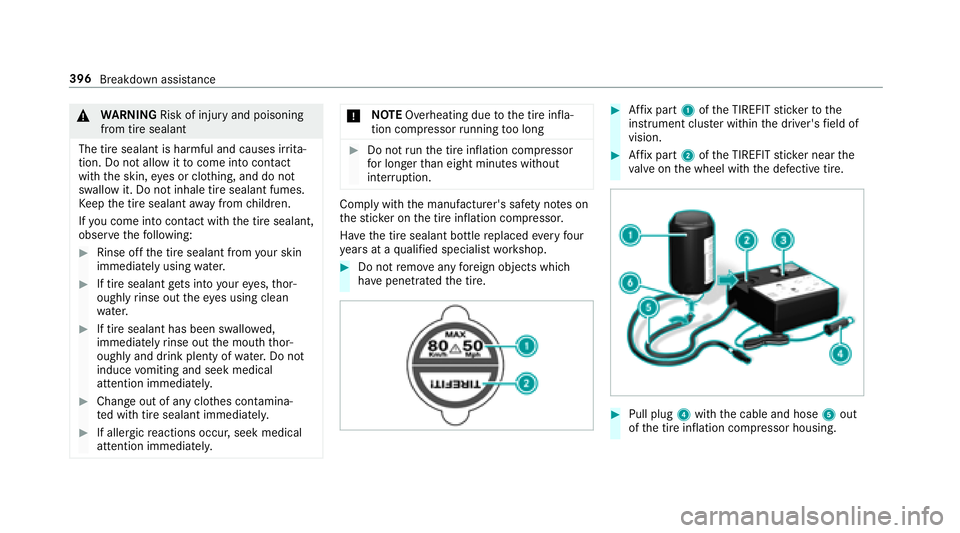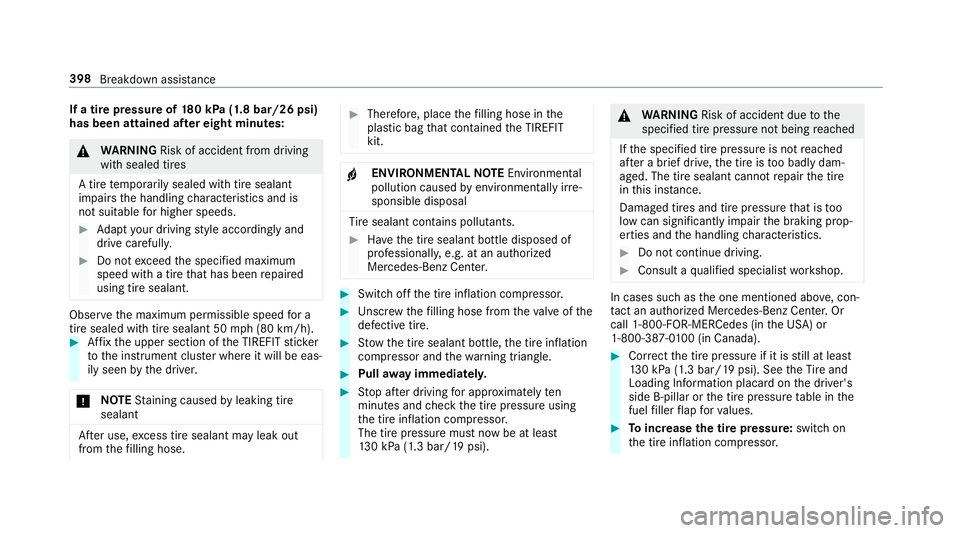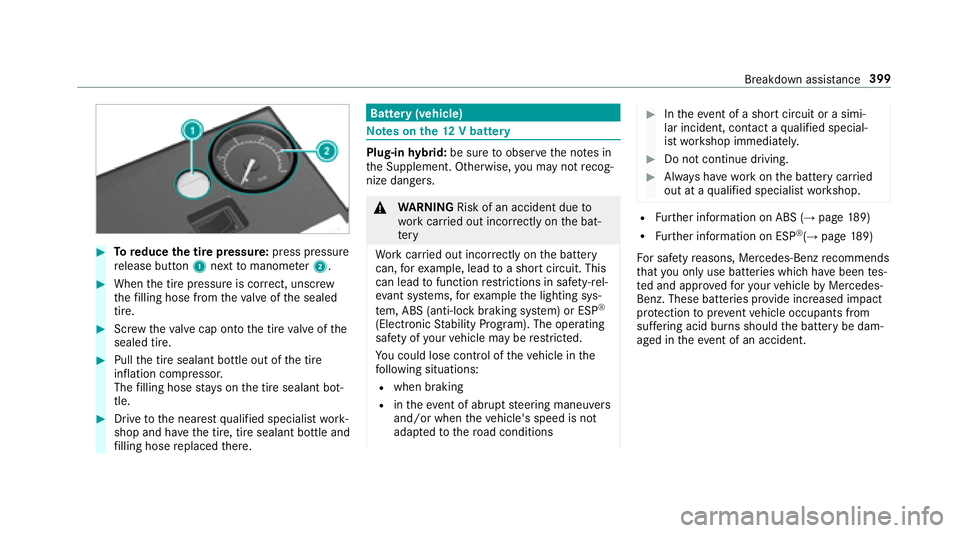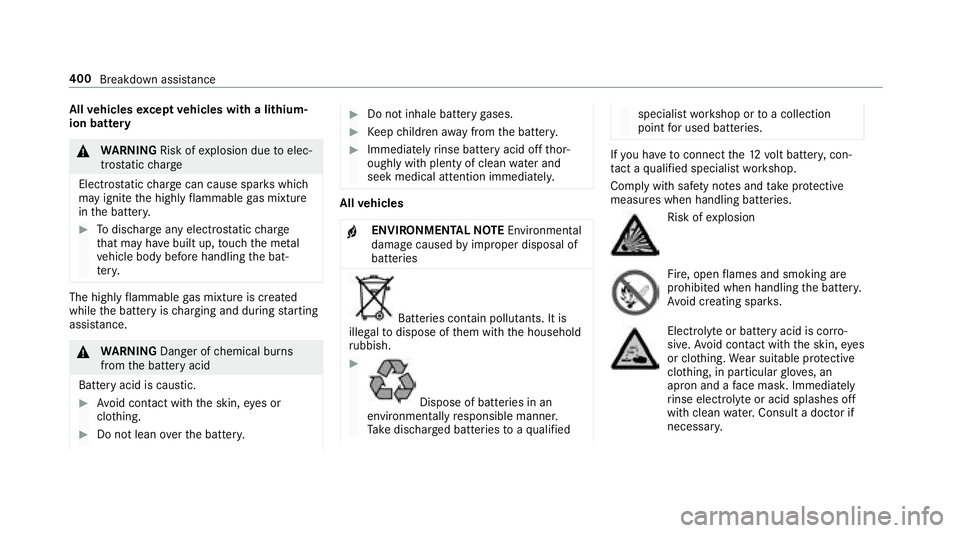2018 MERCEDES-BENZ S-CLASS SEDAN warning
[x] Cancel search: warningPage 395 of 562

Emergency
Re moving the saf etyve st
The saf etyve sts are located in door stowage
compartments 1inthe front door.
#To remo ve:pull out the saf etyve st bag con‐
ta ining the saf etyve st.
#Open the saf etyve st bag and pull out the
saf etyve st.
% Safetyve sts can also be stored in there ar
door stowage compartments.
1Maximum number of washes
2Maximum wash temp erature
3Do not bleach
4Do not iron
5Do not use a laundry dr yer
6Do not dr y-clean
7This is a class 2 vest
The requ irements defined bythe legal standard
are only fulfille difth e saf etyve st isthe cor rect
size and is fully closed.
Re place the saf etyve st if:
RIt is damaged or dirt on there flective strips
can no longer be remo ved
RThe maximum number of washes is exceeded
RThe fluorescence of the saf etyve st has faded
Flat tire
Note s onflat tires
&
WARNING Risk of accident due toaflat
tire
A flat tire se verely affects the driving charac‐
te rist ics as well as thesteering and braking
of theve hicle.
Ti re s without run-flat characteristics:
#Do not drive on with a flat tire.
#Change theflat tire immediately with
th e emer gency spa rewheel or spare
wheel. Alternativel y,consult a qualified
specialist workshop.
Ti re s with run-flat characteristics:
#Observ eth e information and warning
no tes on MOExtended tires (run-flat
tires).
Breakdown assis tance 393
Page 396 of 562

Intheeve nt of a flat tire, thefo llowing options
are available depending on your vehicle's equip‐
ment:
RVe hicles with MOExtended tires: it is pos‐
sible tocontinue the journey for a short
period of time. Make sure you observ eth e
no tes on MOExtended tires (run-flat tires)
(
→page 394).
RVe hicles with a TIREFIT kit: you can repair
th e tire so that it is possible tocontinue the
journ eyfor a short period of time. Todo this,
use the TIREFIT kit (
→page 395).
RVe hicles with Mercedes-Benz
mbrace®(USA only): you can make a call for
Ro adside Assis tance via theove rhead control
panel in the case of a breakdown
(
→page 328).
RAll vehicles: change the wheel
(→page 437).
MOExtended tires (tires with run-flat proper‐
ties)
& WARNING Risk of accident when driving
in li mp-home mode
When driving in emergency mode the han‐
dling characteristics are impaired, e.g. when
cornering, when accelerating stronglyand
when braking.
#Do not exceed the specified maximum
speed.
#Av oid any abrupt steering and driving
maneuvers as well as driving over
obs tacles (curbs, pot holes, off-road).
This applies, in part icular,toa loaded
ve hicle.
#Stop driving in the emer gency mode if
yo u notice:
Rbanging noise
Rvehicle vibration
Rsmoke which smells like rubber
Rcontinuous ESP®inter vention
Rcrac ksin tire side walls
#After driving in emergency mode ha ve
th erims checkedby aqu alified special‐
ist workshop with rega rd totheir fur ther
use.
#The defective tire must be replaced in
eve rycase.
With MOExtended tires (run-flat tires), you can
continue todrive your vehicle even if there is a
tot al loss of pressure in one or more tires. How‐
eve r,th e tire af fected must not show any clearly
visible damage.
Yo u can recognize MOExtended tires bythe
MOExtended marking which appears onthe side
wa ll of the tire.
Ve hicles with tire pressure monitoring sys‐
te m: MOExtended tires may only be used in con‐
junction wi than activated tire pressure monitor‐
ing sy stem.
If a pressure loss warning message appears in
th e multifunction display:
RCheck the tire for dama ge.
394
Breakdown assis tance
Page 397 of 562

RIf driving on, observethefo llowing no tes.
Driving distance possible in limp-home mode
af te r the pressure loss warning:
Load condition Driving distance pos‐
sible in limp-homemode
Pa rtially laden 50 miles (80 km)
Fu lly laden 19miles (30 km)
RThe driving dis tance possible in li mp-home
mode may vary depending on the driving
st yle.
RMaximum permissible speed 50 mph
(80 km/h).
If a tire has gone flat and cannot be replaced
with an MOEx tended tire, you can use a stand‐
ard tire as a temp orary measure.
TIREFIT kit storage location
The TIREFIT kit is located under the trunk floor. Mercedes‑AMG
vehicles: observeth e no tes in
th e Supplement. Otherwise, you may not recog‐
nize dangers.
Plug-in hybrid: obser vethe no tes in the Supple‐
ment. Otherwise, you may not recognize dan‐
ge rs.
1Tire sealant filler bottle
2Ti re inflation compressor
Using the TIREFIT kit
Ha ve thefo llowing readily available:
RTire sealant filler bottle
REnclosed TIREFIT sticke r
RTire inflation compressor
RDisposable glov es
Yo u can use TIREFIT tire sealant toseal punctu‐
re s of up to0.16 in (4 mm), particular lythose in
th e tire conta ct surface.You can use TIREFIT in
outside temp eratures down to-4 °F (-20 °C).
&
WARNING Risk of accident when using
tire sealant.
In thefo llowing situations, the tire sealant is
unable toprov ide suf ficient breakdown assis‐
ta nce, as it is unable toseal the tire proper ly:
RThere are cuts or punctures in the tire
lar gerth an those pr eviously mentioned.
RThe wheel rim is dama ged.
RYo u ha vedriven at a very low tire pres‐
sure or on a flat tire.
#Do not continue driving.
#Consult a qualified specialist workshop.
Breakdown assis tance 395
Page 398 of 562

&WARNING Risk of injury and poisoning
from tire sealant
The tire sealant is harmful and causes ir rita ‐
tion. Do not allow it tocome into contact
wi th th e skin, eyes or clo thing, and do not
swallow it. Do not inhale tire sealant fumes.
Ke ep the tire sealant away from children.
If yo u come into contact withth e tire sealant,
obser vethefo llowing:
#Rinse off the tire sealant from your skin
immediately using water.
#If tire sealant gets into your eyes, thor‐
oughly rinse out theey es using clean
wate r.
#If tire sealant has been swallowe d,
immediately rinse out the mouth thor‐
oughly and drink plenty of water.Do not
induce vomiting and seek medical
attention immediately.
#Change out of any clo thes conta mina‐
te d with tire sealant immediatel y.
#If allergicreactions occur, seek medical
attention immediatel y.
*NO
TEOverheating due tothe tire infla‐
tion compressor running too long
#Do not runth e tire inflation compressor
fo r longer than eight minutes without
inter ruption.
Comply with the manufacturer's saf etyno tes on
th est icke r on the tire inflation compressor.
Ha ve the tire sealant bottle replaced everyfour
ye ars at a qualified specialist workshop.
#Do not remo veany fore ign objects which
ha ve penetra tedth e tire.
#Af fix pa rt1 ofthe TIREFIT sticke rto the
instrument clus ter within the driver's field of
vision.
#Af fix pa rt2 ofthe TIREFIT sticke r near the
va lve on the wheel with the defective tire.
#Pull plug 4with the cable and hose 5out
of the tire inflation compressor housing.
396
Breakdown assis tance
Page 399 of 562

#Pushthe plug of hose 5into flange 6of
tire sealant bottle 1until the plug engages.
#Place tire sealant bottle 1head down wards
into recess 2ofthe tire inflation compres‐
sor.
#Re mo vethe cap from valve 7 onthe defec‐
tive tire.
#Scr ew filling hose 8onto valve 7.
#Insert plug 4into a 12‑V‑sock etinyour
ve hicle.
#Switch on the ignition.
#Press on and off switch 3onthe tire infla‐
tion compressor.
The tire inflation compressor is switched on.
The tire is inflated. Fir st, tire sealant is pum‐
ped into the tire. The pressure may brief ly
ri se toappr oximately 500 kPa (5 bar/73 psi).
Do not switch off the tire inflation compres‐
sor du ring this phase.
#Let the tire inflation compressor runfo r a
maximum of eight minutes.
The tire should then ha veattained a tire
pressure of at least 180 kPa (1.8 bar/26 psi).
If tire sealant leaks out, make sureyou clean the
af fected area as quickly as possible. It is prefera‐
ble touse clean water.
If yo uge t tire sealant on your clo thing, ha veit
cleaned as soon as possible with per chloroe thy‐
lene.
If atire pressure of 180 kPa (1.8 bar/26 psi)
has not been attained af ter eight minutes:
#Switch off the tire inflation compressor.
#Un scr ew thefilling hose from theva lve of the
defective tire.
Please no tethat tire sealant may leak out when
unscr ewing thefilling hose.
#Ve ry slowly drive forw ards or reve rse appr ox‐
imately 33 ft(10 m).
#Pump up the tire again.
Af ter a maximum of eight minutes the tire
pressure must be at least 180 kPa (1.8 bar/
26 psi).
& WARNING Risk of accident due tothe
specified tire pressure not being reached
If th e specified tire pressure is not reached
af te rth e specified time, the tire is too badly
damaged. The tire sealant cannot repair the
tire in this ins tance.
Dama ged tires and a tire pressure that is too
low can significantly impair braking and han‐
dling characteristics.
#Do not continue driving.
#Consult a qualified specialist workshop.
Breakdown assis tance 397
Page 400 of 562

If a tire pressureof180 kPa (1.8 bar/26 psi)
has been attained af ter eight minutes:
&
WARNING Risk of accident from driving
wi th sealed tires
A tire temp orarily sealed with tire sealant
impairs the handling characteristics and is
not suitable for higher speeds.
#Ad apt your drivin gst yle according lyand
drive carefull y.
#Do notexceed the specified maximum
speed with a tire that has been repaired
using tire sealant.
Obser vethe maximum permissible speed for a
tire sealed with tire sealant 50 mph(8 0 km/h).
#Af fix th e upper section of the TIREFIT sticke r
to the instrument clus ter where it will be eas‐
ily seen bythe driver.
* NO
TEStaining caused byleaking tire
sealant
Af ter use, excess tire sealant may leak out
from thefilling hose.
#Therefore, place thefilling hose in the
plastic bag that con tained the TIREFIT
kit.
+ENVIRONMEN TALNO TEEnvironmental
pollution caused byenvironmen tally ir re‐
sponsible disposal
Ti re sealant contains polluta nts.
#Have the tire sealant bottle disposed of
professionall y,e.g. at an authorized
Mercedes-Benz Center.
#Switch off the tire inflation compressor.
#Un scr ew thefilling hose from theva lve of the
defective tire.
#St ow th e tire sealant bottle, the tire inflation
compressor and thewa rning triangle.
#Pull away immediatel y.
#Stop af ter driving for app roxima tely ten
minutes and check the tire pressure using
th e tire inflation compressor.
The tire pressure must now be at least
13 0 kPa (1.3 bar/19 psi).
&
WARNING Risk of accident due tothe
specified tire pressure not being reached
If th e specified tire pressure is not reached
af te r a brief drive, the tire is too badly dam‐
aged. The tire sealant cannot repair the tire
in this ins tance.
Dama ged tires and tire pressure that is too
low can significantly impair the braking prop‐
erties and the handling characteristics.
#Do not continue driving.
#Consult a qualified specialist workshop.
In cases such as the one mentioned abo ve, con‐
ta ct an au thorized Mercedes-Benz Center. Or
call 1-800-FOR-MERC edes (inthe USA) or
1-800-387-0 100 (in Canada).
#Cor rect the tire pressure if it is still at least
13 0 kPa (1.3 bar/19 psi). See theTire and
Loading Info rmation placard on the driver's
side B‑pillar or the tire pressure table in the
fuel filler flap forva lues.
#To increase the tire pressure: switchon
th e tire inflation compressor.
398
Breakdown assis tance
Page 401 of 562

#Toreduce the tire pressure: press pressure
re lease button 1next tomanome ter2.
#When the tire pressure is cor rect, unscr ew
th efilling hose from theva lve of the sealed
tire.
#Scr ew theva lve cap onto the tire valve of the
sealed tire.
#Pull the tire sealant bottle out of the tire
inflation compressor.
The filling hose stay s on the tire sealant bot‐
tle.
#Drive tothe nearest qualified specialist work‐
shop and ha vethe tire, tire sealant bottle and
fi lling hose replaced there.
Bat tery (vehicle)
Note s onthe12 V battery
Plug-in hybrid: be sure toobser vethe no tes in
th e Supplement. Otherwise, you may not recog‐
nize dangers.
& WARNING Risk of an accident due to
wo rkcar ried out incor rectly on the bat‐
te ry
Wo rkcar ried out incor rectly on the battery
can, forex ample, lead toa short circuit. This
can lead tofunction restrictions in saf ety-re l‐
eva nt sy stems, forex ample the lighting sys‐
te m, ABS (anti-lock braking system) or ESP
®
(Elect ronic Stability Program). The operating
saf etyof your vehicle may be restricted.
Yo u could lose cont rol of theve hicle in the
fo llowing situations:
Rwhen braking
Rin theeve nt of ab rupt steering maneuvers
and/or when theve hicle's speed is not
adap tedto thero ad conditions
#In theeve nt of a short circuit or a simi‐
lar incident, contact a qualified special‐
ist workshop immediately.
#Do not continue driving.
#Alw ays ha vewo rkon the battery car ried
out at a qualified specialist workshop.
RFu rther information on ABS (→page 189)
RFurther information on ESP®(→page 189)
Fo r saf etyre asons, Mercedes-Benz recommends
th at you only use batte ries which ha vebeen tes‐
te d and appr ovedfo ryo ur vehicle byMercedes-
Benz. These batteries pr ovide inc reased impact
pr otection toprev ent vehicle occupants from
suf fering acid bu rns should the battery be dam‐
aged in theeve nt of an accident.
Breakdown assist ance399
Page 402 of 562

Allvehicles except vehicles with a lithium-
ion battery
& WARNING Risk ofexplosion due toelec‐
tros tatic charge
Electros taticch arge can cause spark s which
may ignite the highly flammable gas mixture
in the batter y.
#Todischar geany electros tatic charge
th at may ha vebuilt up, touch the me tal
ve hicle body before handling the bat‐
te ry.
The highly flammable gas mixture is created
while the battery is charging and during starting
assis tance.
&
WARNING Danger of chemical burns
from the battery acid
Battery acid is caustic.
#Av oid contact with the skin, eyes or
clo thing.
#Do not lean overth e batter y.
#Do not inhale battery gases.
#Ke ep children away from the batter y.
#Immediate lyrinse battery acid off thor‐
oughly with plenty of clean water and
seek medical attention immediately.
All vehicles
+ENVIRONMENTAL NOTEEnvironmental
damage causedbyimproper disposal of
batteries
Bat teries conta in pollutants. It is
illegal todispose of them with the household
ru bbish.
#
Dispose of batteries in an
environmen tally responsible manner.
Ta ke dischar ged batteries toaqu alified
specialist workshop or toa collection
point for used batteries.
If yo u ha vetoconnect the12 volt batter y,con‐
ta ct a qualified specialist workshop.
Comply with saf etyno tes and take protective
measures when handling batteries.
Risk of explosion
Fire, open flames and smoking are
prohibite d when handling the batter y.
Av oid creating spar ks.
Electrolyte or battery acid is cor ro‐
sive. Avoid contact with the skin, eyes
or clo thing. Wear suitable pr otective
clo thing, in particular glove s, an
apron and a face mas k.Immediate ly
ri nse electrolyte or acid splashes off
with clean water.Consult a docto r if
necessar y.
400
Breakdown assis tance